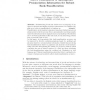Free Online Productivity Tools
i2Speak
i2Symbol
i2OCR
iTex2Img
iWeb2Print
iWeb2Shot
i2Type
iPdf2Split
iPdf2Merge
i2Bopomofo
i2Arabic
i2Style
i2Image
i2PDF
iLatex2Rtf
Sci2ools
CICLING
2005
Springer
2005
Springer
Direct Combination of Spelling and Pronunciation Information for Robust Back-Transliteration
Abstract. Transliterating words and names from one language to another is a frequent and highly productive phenomenon. For example, English word cache is transliterated in Japanese as “kyasshu”. Transliteration is information losing since important distinctions are not always preserved in the process. Hence, automatically converting transliterated words back into their original form is a real challenge. Nonetheless, due to its wide applicability in MT and CLIR, it is an interesting problem from a practical point of view. In this paper, we demonstrate that back-transliteration accuracy can be improved by directly combining grapheme-based (i.e. spelling) and phoneme-based (i.e. pronunciation) information. Rather than producing back-transliterations based on grapheme and phoneme model independently and then interpolating the results, we propose a method of first combining the sets of allowed rewrites (i.e. edits) and then calculating the back-transliterations using the combined set. ...
Back-transliteration Accuracy | CICLING 2005 | English Word Cache | Natural Language Processing | Transliterated Words |
| Added | 26 Jun 2010 |
| Updated | 26 Jun 2010 |
| Type | Conference |
| Year | 2005 |
| Where | CICLING |
| Authors | Slaven Bilac, Hozumi Tanaka |
Comments (0)

